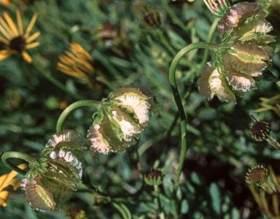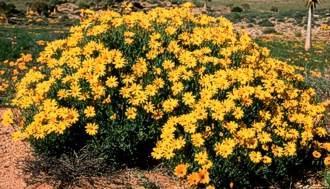Osteospermum oppositifolium
Osteospermum oppositifolium (Aiton) Norl. (= Tripteris oppositifolia (Aiton) B.Nord.)
Family: Asteraceae
Common names: stinkskaapbos, skaapbos (Afr.)
Introduction
The golden, orange or yellow flowers of Osteospermum oppositifolium make a stunning show in spring.

Description
Description
Osteospermum oppositifolium is a dwarf shrub up to 1 m high. The leaves are semi-succulent, opposite, oblong, greyish green with smooth margins. The large flower heads are solitary (borne singly) and pedunculate (short-stalked). The involucral bracts are brown, divided, with appendages on bracts, uniform, in a single row. The yellow or orange ray florets are distinctly longer than the involucre. The disc florets are dark purple. The fruits develop from the ray florets. They are three-winged, hence the genus name, with three apical windows. Flowering time is from autumn to spring (May to October) with peak flowering in late winter and spring, between August and September.

Conservation Status
Status
Osteospermum oppositifolium is assessed as Least Concern (LC) on the Red List of South African plants, it is quite common in the areas where it occurs naturally.
Distribution and habitat
Distribution description
Osteospermum oppositifolium is found from Vanrhynsdorp in Namaqualand up to as far as Namibia. The soils and habitats listed on herbarium specimens include dry, sandy, rocky ground; well-drained, loamy clay soil; along the road; semi-desert and succulent karoo. Altitude ranges from 75 to 1 000 m.
Derivation of name and historical aspects
History
This species was previously placed in the genus Tripteris, the genus name is derived from the Greek words, tri meaning ‘three’, and pteris meaning ‘wings’. It is currently placed in the genus Osteospermum, this genus name also derived from Greek, osteon meaning ‘bone’ and spermum meaning ‘seed’. The species name oppositifolium means that the leaves are oppositely arranged. Originally this species was described as Calendula oppositifolia by William Aiton (1731-1793), a British gardener and botanist of the Royal Botanic Gardens at Kew (Aiton 1789). The name was changed to Osteospermum oppositifolium by Norlind (1960), a Swedish botanist, who was the curator of the Botanical Museum of Lund from 1950 to 1961. He was interested in taxonomy, morphology, phytogeography, cytology and ecology, especially of South African Compositae (Calenduleae) and the flora of Mongolia. In 1994, Nordenstam synonymized O. oppositifolia under Tripteris oppositifolia. He is a Swedish botanist, who was the curator of in Swedish Museum of Stockholm in 1969, and is interested in taxonomy and phytogeography of South African Compositae and Liliaceae. At present it is back in the genus Osteospermum.
Ecology
Ecology
Osteospermum oppositifolium flowers are visited by bees, wasps and butterflies, as well as by yellow spiders that match the flower heads exactly in colour. The fruits are winged, so are easily dispersed by wind. Plants in Namibia are more hairy compared to those found in Namaqualand. This may help reduce water loss and help them to survive in the dry conditions in the desert.

Uses
Use
Osteospermum oppositifolium is aromatic and palatable to stock and game, especially when in flower.
Growing Osteospermum oppositifolium
Grow
Sow seeds directly into prepared beds on a calm day when the wind will not blow them away. For best results, prepare the beds with compost and keep beds moist to trigger germination. They also grow very well in rocky, well-drained, sandy soil areas. As it is palatable to animals, farmers can plant it on farms as a type of backup fodder plant. For spring display grow Osteospermum oppositifolium together with Didelta carnosa (seegousblom), Euryops pectinatus (gouemargrietjie), Euryops virgineus (rivierharbuisbos) and Pteronia incana (laventelbossie).
References
- Aiton, W. 1789. Diadelphia-Cryptogamia. Hortus Kewenis 3: 272.
- Joffe, P. 2003. Easy guide to indigenous shrubs. Briza Publications, Pretoria.
- Le Roux, A. 2005. Namaqualand. South African Wild Flower Guide 1. Botanical Society of South Africa, Cape Town.
- Nordenstam, B. 1994. New combinations in the tribe Calenduleae. Compositae Newsletter 25: 46.
- Norlindh, T. 1960. Subgenus Tripteris (Less.) T.Norl., section Trifenestrata T.Norl. Botaniska Notiser 113: 393-399.
- Plants of the World Online, Osteospermum oppositifolium (Aiton) Norl. https://powo.science.kew.org/taxon/urn:lsid:ipni.org:names:235851-1. Accessed 10/07/22.
- Raimondo, D., Von Staden, L., Foden, W., Victor, J.E., Helme, N.A., Turner, R.C., Kamundi, D.A. & Manyama, P.A. (eds) 2009. Red list of South African plants. Strelitzia 25. South African National Biodiversity Institute, Pretoria.
- Stafleu, F.A. & Cowan, R.S. 1976. A selective guide to botanical publications and collections with dates, commentaries and types. Taxonomic Literature 1A-G, edn 2. Bohn, Scheltema & Holkema, Utrecht.
Credits
Swelankomo Nonkululeko
National Herbarium, Pretoria
January 2009
Updated July 2022
Plant Attributes:
Plant Type: Shrub
SA Distribution: Northern Cape, Western Cape
Soil type: Sandy, Loam
Flowering season: Spring, Winter
PH: Acid, Neutral
Flower colour: Purple, Yellow, Orange
Aspect: Full Sun
Gardening skill: Average
Special Features:
Horticultural zones








Rate this article
Article well written and informative
Rate this plant
Is this an interesting plant?
Login to add your Comment
Back to topNot registered yet? Click here to register.